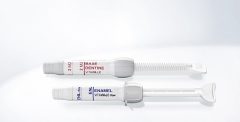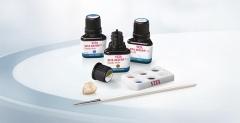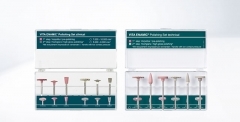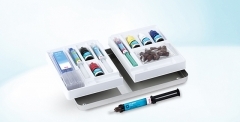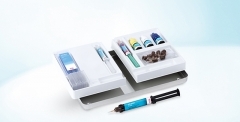VITA ENAMIC is a monochromatic CAD/CAM block that is available in three translucency levels (T, HT, ST). If you are looking for the perfect inlay, onlay or tabletop material for your daily practice, look no further than VITA ENAMIC ST.
VITA ENAMIC®
The only hybrid dental ceramic in the world with a dual network structure.

Gentle
Chewing force-absorbing material properties ensure gentle protection for the antagonists.
Non-invasive / minimally invasive
Hybrid ceramic enables non-invasive / minimally invasive design with precise wall thicknesses.
Reliable
Stable edges, precise and secure reconstructions, thanks to the secure dual network structure.
Indications
- Anterior and posterior crowns on implants
- Anterior and posterior crowns
- Inlays / Onlays / Partial crowns
- Table tops
- Veneers
These are recommended indications. The entire range of single tooth restorations can normally be fabricated. For details, please refer to the respective instructions for use of the products.
VITA ENAMIC – SYSTEM SOLUTIONS*
VITA offers VITA ENAMIC with specific holder systems for the CAD/CAM systems:
- CEREC/inLab (Dentsply Sirona)
- PlanMill 40/PlanMill 40S/PlanMill 50S (Planmeca)
VITA ENAMIC – UNIVERSAL SOLUTIONS*
- Arum Dental (5x series)
- CORiTEC Serie (imes-icore GmbH)
- Röders RXD Serie(Röders GmbH)
- DGSHAPE DWX Serie (DGSHAPE Corporation)
- CS 3000/CS3100 (Carestream Dental, Inc)
- Zfx Inhouse5x (Zfx GmbH)
- Milling UNIT M Serie (Zirkonzahn S.r.l.)
- N4/R5/S1/S2/Z4 (vhf camfacture AG)
- Organical Desktop Serie (R+K CAD/CAM Technologie GmbH)
- DMG ULTRASONIC-Serie (DMG Mori AG)
*) Note: The range of VITA CAD/CAM material versions/geometries/shades available may vary for individual CAD/CAM system partners or systems. The hardware and software requirements in each case are available from the respective CAD/CAM system partners.
VITA ENAMIC® for CEREC®/inLab® VITA SYST
| Description | Prod. no. 5 pcs. |
|---|---|
| 0M1-HT, EM-10 |
EC40M1HTEM10 8 x 10 x 15 mm |
| 0M1-HT, EM-14 |
EC40M1HTEM14 12 x 14 x 18 mm |
| 0M1-T, EM-14 |
EC40M1TEM14 12 x 14 x 18 mm |
| 1M1-HT, EM-10 |
EC41M1HTEM10 8 x 10 x 15 mm |
| 1M1-HT, EM-14 |
EC41M1HTEM14 12 x 14 x 18 mm |
| 1M1-T, EM-14 |
EC41M1TEM14 12 x 14 x 18 mm |
| 1M2-HT, EM-10 |
EC41M2HTEM10 8 x 10 x 15 mm |
| 1M2-HT, EM-14 |
EC41M2HTEM14 12 x 14 x 18 mm |
| 1M2-T, EM-14 |
EC41M2TEM14 12 x 14 x 18 mm |
| 2M2-HT, EM-10 |
EC42M2HTEM10 8 x 10 x 15 mm |
| 2M2-HT, EM-14 |
EC42M2HTEM14 12 x 14 x 18 mm |
| 2M2-T, EM-14 |
EC42M2TEM14 12 x 14 x 18 mm |
| 3M2-HT, EM-10 |
EC43M2HTEM10 8 x 10 x 15 mm |
| 3M2-HT, EM-14 |
EC43M2HTEM14 12 x 14 x 18 mm |
| 3M2-T, EM-14 |
EC43M2TEM14 12 x 14 x 18 mm |
| 2M1-T, EM-14 |
EC4EM3112765 12 x 14 x 18 mm |
| 2M3-T, EM-14 |
EC4EM3132765 12 x 14 x 18 mm |
| 3M1-T, EM-14 |
EC4EM3192765 12 x 14 x 18 mm |
| 3M3-T, EM-14 |
EC4EM3212765 12 x 14 x 18 mm |
| 4M2-T, EM-14 |
EC4EM3282765 12 x 14 x 18 mm |
| 2M1-HT, EM-10 |
EC4EM4112645 8 x 10 x 15 mm |
| 2M1-HT, EM-14 |
EC4EM4112765 12 x 14 x 18 mm |
| 2M3-HT, EM-10 |
EC4EM4132645 8 x 10 x 15 mm |
| 2M3-HT, EM-14 |
EC4EM4132765 12 x 14 x 18 mm |
| 3M1-HT, EM-10 |
EC4EM4192645 8 x 10 x 15 mm |
| 3M1-HT, EM-14 |
EC4EM4192765 12 x 14 x 18 mm |
| 3M3-HT, EM-10 |
EC4EM4212645 8 x 10 x 15 mm |
| 3M3-HT, EM-14 |
EC4EM4212765 12 x 14 x 18 mm |
| 4M2-HT, EM-10 |
EC4EM4282645 8 x 10 x 15 mm |
| 4M2-HT, EM-14 |
EC4EM4282765 12 x 14 x 18 mm |
| 1M1-ST, EM-14 |
EC4EM7062765 12 x 14 x 18 mm |
| 1M2-ST, EM-14 |
EC4EM7072765 12 x 14 x 18 mm |
| 2M2-ST, EM-14 |
EC4EM7122765 12 x 14 x 18 mm |
| 3M2-ST, EM-14 |
EC4EM7202765 12 x 14 x 18 mm |
| 4M2-ST, EM-14 |
EC4EM7282765 12 x 14 x 18 mm |
VITA ENAMIC® UNIVERSAL VITA SYSTEM 3D-MA
| Description | Prod. no. 5 pcs. |
|---|---|
| 0M1-HT, EM-10 |
EN1EM4022645 8 x 10 x 15 mm |
| 0M1-HT, EM-14 |
EN1EM4022765 12 x 14 x 18 mm |
| 0M1-T, EM-14 |
EN1EM3022765 12 x 14 x 18 mm |
| 1M1-HT, EM-10 |
EN1EM4062645 8 x 10 x 15 mm |
| 1M1-HT, EM-14 |
EN1EM4062765 12 x 14 x 18 mm |
| 1M1-T, EM-14 |
EN1EM3062765 12 x 14 x 18 mm |
| 1M2-HT, EM-10 |
EN1EM4072645 8 x 10 x 15 mm |
| 1M2-HT, EM-14 |
EN1EM4072765 12 x 14 x 18 mm |
| 1M2-T, EM-14 |
EN1EM3072765 12 x 14 x 18 mm |
| 2M2-HT, EM-10 |
EN1EM4122645 8 x 10 x 15 mm |
| 2M2-HT, EM-14 |
EN1EM4122765 12 x 14 x 18 mm |
| 2M2-T, EM-14 |
EN1EM3122765 12 x 14 x 18 mm |
| 3M2-HT, EM-10 |
EN1EM4202645 8 x 10 x 15 mm |
| 3M2-HT, EM-14 |
EN1EM4202765 12 x 14 x 18 mm |
| 3M2-T, EM-14 |
EN1EM3202765 12 x 14 x 18 mm |
| 4M2-HT, EM-10 |
EN1EM4282645 8 x 10 x 15 mm |
| 4M2-HT, EM-14 |
EN1EM4282765 12 x 14 x 18 mm |
| 4M2-T, EM-14 |
EN1EM3282765 12 x 14 x 18 mm |
| 1M1-ST, EM-14 |
EN1EM7062765 12 x 14 x 18 mm |
| 1M2-ST, EM-14 |
EN1EM7072765 12 x 14 x 18 mm |
| 2M2-ST, EM-14 |
EN1EM7122765 12 x 14 x 18 mm |
| 3M2-ST, EM-14 |
EN1EM7202765 12 x 14 x 18 mm |
| 4M2-ST, EM-14 |
EN1EM7282765 12 x 14 x 18 mm |
VITA ENAMIC® IS for CEREC®/inLab® VITA S
| Description | Prod. no. 5 pcs. |
|---|---|
| 1M1-HT, IS-16L |
EC4EM4069485 18 x 16 x 18 mm |
| 1M1-HT, IS-16S |
EC4EM4069365 18 x 16 x 18 mm |
| 1M1-T, IS-14L |
EC4EM3069725 18 x 14 x 12 mm |
| 1M1-T, IS-14S |
EC4EM3069605 18 x 14 x 12 mm |
| 1M2-HT, IS-16L |
EC4EM4079485 18 x 16 x 18 mm |
| 1M2-HT, IS-16S |
EC4EM4079365 18 x 16 x 18 mm |
| 1M2-T, IS-14L |
EC4EM3079725 18 x 14 x 12 mm |
| 1M2-T, IS-14S |
EC4EM3079605 18 x 14 x 12 mm |
| 2M2-HT, IS-16L |
EC4EM4129485 18 x 16 x 18 mm |
| 2M2-HT, IS-16S |
EC4EM4129365 18 x 16 x 18 mm |
| 2M2-T, IS-14L |
EC4EM3129725 18 x 14 x 12 mm |
| 2M2-T, IS-14S |
EC4EM3129605 18 x 14 x 12 mm |
| 3M2-HT, IS-16L |
EC4EM4209485 18 x 16 x 18 mm |
| 3M2-HT, IS-16S |
EC4EM4209365 18 x 16 x 18 mm |
| 3M2-T, IS-14L |
EC4EM3209725 18 x 14 x 12 mm |
| 3M2-T, IS-14S |
EC4EM3209605 18 x 14 x 12 mm |
| 4M2-HT, IS-16L |
EC4EM4289485 18 x 16 x 18 mm |
| 4M2-HT, IS-16S |
EC4EM4289365 18 x 16 x 18 mm |
| 4M2-T, IS-14L |
EC4EM3289725 18 x 14 x 12 mm |
| 4M2-T, IS-14S |
EC4EM3289605 18 x 14 x 12 mm |
Easy download for multiple documents
Download a .zip file containing all the selected files in a single step.Simply tick the files then click here.
VITAVM®LC
Light-curing, microparticle composite for extraoral use with fixed and removable restorations.
VITA AKZENT® LC
Reliable reproduction of individual shade effects.
VITA ENAMIC® Polishing Set
For simple pre- and high-gloss polishing of VITA ENAMIC hybrid ceramic.
VITA ADIVA® FULL-ADHESIVE
The fully adhesive bonding system with ideally matched components for material-specific and process-safe bonding of restorations made from various materials.
VITA ADIVA® SELF-ADHESIVE
The self-adhesive bonding system with ideally matched components for material-specific and process-safe bonding of restorations made from various materials.
 It appears that you are currently in USA.
It appears that you are currently in USA.
